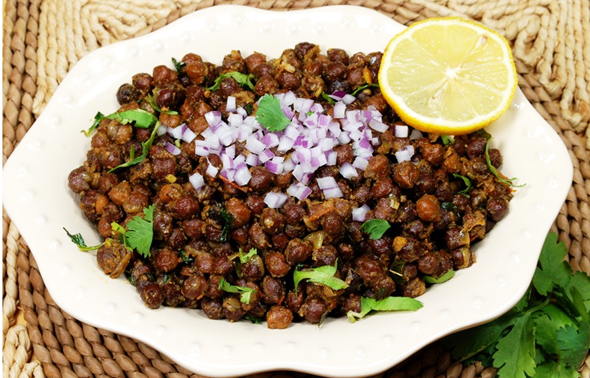Mama’s Punjabi Recipes: Kale Channe da Snack (Black Chicpea Snack)
Many people don’t mind eating boiled safayd chole (white chickpeas) in snacks like gol gappas (also known as pani puri elsewhere in India) or in aaloo chaats, Boiled chickpeas are even served in many mainstream American restaurants as an item to be mixed in when creating your own salad. One of the main reasons for this is that chole are cheap and widely available – even pre-cooked in a can – and are easy to boil and serve without messing up.
The other type of chole – the kale channe (black chickpeas) which are actually cheaper – are also appreciated by desis for their taste, but are still not as widely cooked as their white cousins and are not known in mainstream American circles. They are small, hard and covered with a reddish brown skin and are just as easy to make, but are much more flavorful, a better source of protein and are easier to digest.
Roasted and skinless kale channe are usually ground up to make besan flour, so many people eat them regularly but just don’t realize it. Left to soak in water, the channe will start to sprout and some people use them for salads.
Across India, many eat kale channe at certain religious festivals but and otherwise it is seldom made at home. Among Punjabi families and Northern Indians, kale channe curry is usually a special treat, eaten with plain or tandoori roti. But one of the best ways to eat them are semi dry, with a thickened sauce, as an appetizer, garnished with chopped chilies, raw onions and dhania (coriander) leaves, with puris or kulchas, which hawkers and specialty restaurants serve across North India.
A side benefit to cooking kale channe bean is that the water used to boiling them contains minerals and drunk as a clear soup for its fortifying power. It is served to recovering sick people to give them added strength.
Ingredients :
2 cups kale channe (black chickpeas)
5 cups of pani (water)
100 gm paneer (Indian cottage cheese)
2 uble hua ande (hard boiled eggs) optional
1 small piyaaz (onion)
Spices (to taste): namak (salt), mirch (red pepper), garam masala, amchoor (dried mango powder)
Garnishes (to taste): hari mirchen (long green chillies), dhania (coriander), nimbu (lemon)
Directions:
1. Wash the kale channe well, then pour into a pot and let them soak overnight in warm water.
2. Wash them again in the morning and then pour them with the water in a pressure cooker. Bring to a boil; wait you get 5 or 6 whistles before opening the cooker up. They are usually well cooked after 6 whistles. Do not add salt or baking soda when boiling the channe as they are naturally salty and the soda only upsets the stomach.
3. If you don’t have a pressure cooker, you can boil them in a full pot of water for at least 90 minutes under medium low heat. If you need to add more water when boiling, you can do so.
4. Pour through a sieve and save the water to serve as a soup. Put the boiled kale channe in a mixing bowl.
5. Cut the paneer into small pieces. If you want to add the boiled eggs, likewise chop them into small pieces. Finely chop the onions, chillies and dhania.
6. Throw them in the bowl with the kale channe and mix gently so as not to break up the paneer and eggs. Add the salt, pepper, amchoor, garam masala and dhania and squeeze in some lemon juice and mix well.
7. Put in the fridge for 30 minutes before serving cold as an appetizer.
MAMA’S TIP OF THE WEEK
USE MASHED POTATOES FROM THE HOLIDAYS TO MAKE PARANTHAS
For the Thanksgiving and Christmas Holidays, the traditional meals call for a side dish of mashed potatoes, and usually there are plenty of leftovers. If the mashed potatoes are not made with milk or cream or too much water, then they are perfect to be used for as stuffing for aaloo paranthas (stuffed potato flatbread). Simply mix in some red pepper, amchoor (dried mango powder) and garam masala and then scoop in some amount into the rolled out dough. Add the salt at the last minute as it sheds water if mixed into the stuffing.
Shakuntla Malhotra is a skilled cook of Punjabi dishes made in the old-fashioned style that she learnt as a young woman in her ancestral home in Lyallpur, India before it became part of Pakistan after the Partition in 1947. People have often admired her cooking for its simplicity and taste that comes with each mouthful. Even in her mid-eighties, she continues to cook daily and agreed to share some of her delectable Punjabi recipes.


